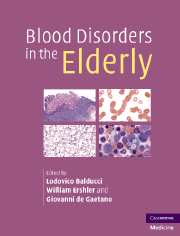Book contents
- Frontmatter
- Contents
- List of contributors
- Preface
- Part I Epidemiology
- Part II Hematopoiesis
- Part III Anemia of aging
- Part IV Hematologic malignancies and aging
- Part V Disorders of hemostasis in the elderly
- 26 Acquired hemophilia in the elderly
- 27 Blood coagulation and aging
- 28 Platelet disorders in the elderly
- 29 Gene—environment interactions and vascular risk in the elderly
- 30 Antithrombotic therapy: guidelines for the elderly
- Index
26 - Acquired hemophilia in the elderly
from Part V - Disorders of hemostasis in the elderly
Published online by Cambridge University Press: 21 October 2009
- Frontmatter
- Contents
- List of contributors
- Preface
- Part I Epidemiology
- Part II Hematopoiesis
- Part III Anemia of aging
- Part IV Hematologic malignancies and aging
- Part V Disorders of hemostasis in the elderly
- 26 Acquired hemophilia in the elderly
- 27 Blood coagulation and aging
- 28 Platelet disorders in the elderly
- 29 Gene—environment interactions and vascular risk in the elderly
- 30 Antithrombotic therapy: guidelines for the elderly
- Index
Summary
Introduction
The acquired hemophilia syndrome occurs more frequently in advanced age: the majority of the patients are over 60 years, and comorbidities are frequent. Acquired hemophilia is a rare clinical syndrome characterized by acute bleeding, either spontaneous or related to surgery or trauma, in patients with negative family and personal history, and it may be severe and fatal. The depletion of factor VIII (FVIII:C), or much less frequently of other factors, is mediated by specific autoantibodies, directed against functional epitopes with neutralization and/or accelerated clearance of the factor from the plasma.
The clinical information discussed in this chapter is retrieved from reports including more than ten patients and from a survey of the Italian hemophilia centers.
Epidemiology
The incidence of acquired hemophilia varies between 0.1 and 1.0 cases per million population per year, but it is likely that not all affected patients are included in the published surveys. The median age at presentation varies between 55 and 78 years (Table 26.1), with equal distribution between the sexes except in the younger age groups because of the cases related to pregnancy (Table 26.2). Acquired hemophilia is commonly associated with a variety of clinical conditions: autoimmune diseases (systemic lupus erythematosus, rheumatoid arthritis, asthma), solid tumors, lymphoproliferative diseases, and pregnancy, but in 50% it is idiopathic (Table 26.3).
- Type
- Chapter
- Information
- Blood Disorders in the Elderly , pp. 387 - 405Publisher: Cambridge University PressPrint publication year: 2007
- 5
- Cited by



